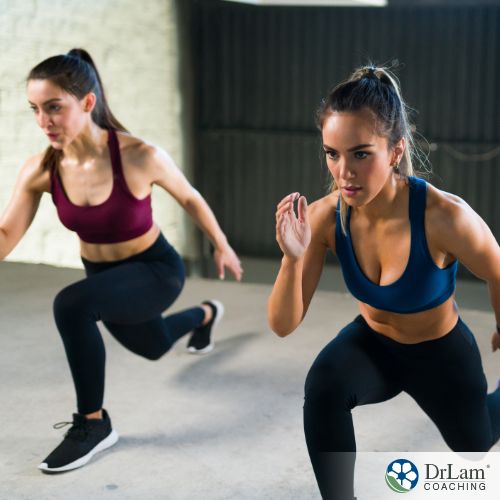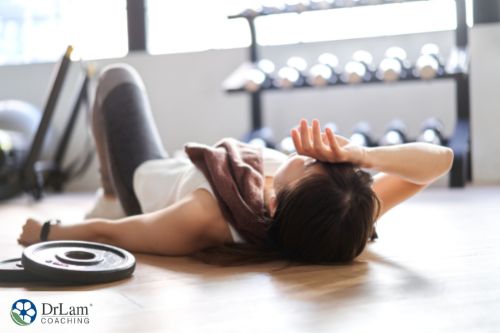 Exercising is well known to have several health and wellness benefits. Although this is common knowledge in society today, many people still don’t exercise enough. One of the biggest excuses for insufficient physical inactivity is lack of time. However, with HIIT exercise, people can enjoy the benefits of physical activity in minimal time.
Exercising is well known to have several health and wellness benefits. Although this is common knowledge in society today, many people still don’t exercise enough. One of the biggest excuses for insufficient physical inactivity is lack of time. However, with HIIT exercise, people can enjoy the benefits of physical activity in minimal time.
Here, we will consider what HIIT is and how you can effectively incorporate it into your schedule. Keep in mind that these tips are for those who are healthy and not dealing with the later stages of adrenal fatigue. If you feel great with exercise, then HIIT might be a good option for you. However, if you feel tired after exertion, do not push your body with HIIT exercise.
HIIT is an acronym for high-intensity interval training. It is a unique form of exercise that alternates short bursts of intense exercise with lower-intensity recovery periods.
During the bursts of intense exercise, the heart works at around 80 to 90 percent of its maximum heart rate capacity. During low-intensity periods, the heart works at 40 to 50 percent of its maximal capacity. HIIT exercise typically lasts no longer than 30 minutes, involving six to ten separate alternations of high- and low-intensity sessions.
HIIT often entails aerobic or resistance training exercises. Activities like swimming, running, and cycling can be performed using the HIIT strategy. The type of exercise determines the duration and intensity of the sessions, the recovery periods, and the number of sets the exercise will involve.
Experts describe HIIT as the most time-efficient exercise strategy. Studies show that HIIT can be even more beneficial than moderate-intensity but continuous training. This addresses the time commitment obstacle associated with moderate-intensity exercise.
Aside from being time-efficient, there are several proven health benefits of HIIT. We will examine four of these benefits below.
One of the perks of physical activity is improving the state of the heart and, in general, the circulatory system. This also applies to HIIT exercise. Several studies show that HIIT is beneficial to cardiovascular health and to a greater extent than moderate-intensity continuous exercise.
A study on hypertensive individuals sought to determine exercise modalities that could help reduce arterial stiffness and blood pressure, which both increase the risks of cardiovascular events.
The results showed that both continuous and interval exercise were beneficial for blood pressure control. However, only interval exercise reduced arterial stiffness.
Note that this study was for people who already had hypertension. HIIT was not as beneficial for people with a normal blood pressure range.
Further, another study concluded that HIIT positively affects cardiorespiratory functions, traditional cardiovascular disease risk factors, oxidative stress, and inflammation. All of these are essential in improving vascular function. In particular, inflammation has been linked with heart attacks and strokes.
Aside from the impact on cardiovascular health, chronic inflammation can cause Adrenal Fatigue Syndrome (AFS), a condition where the body’s stress response cannot keep up with life’s chronic stressors. Interestingly, one of the ways of managing adrenal fatigue involves doing the right kind of exercise. If AFS is in the early stages, HIIT exercise can help manage the condition.
Metabolic syndrome is a group of conditions occurring together that elevate the risk of coronary heart disease, stroke, type-2 diabetes, and other serious health issues. The condition is characterized by body fat around the waist, increased blood pressure, abnormal triglyceride or cholesterol levels, and high fasting blood glucose.
Over the last few years, the occurrence of metabolic syndrome has increased, and about one in three American adults have the condition.
Metabolic problems can also result from a dysregulation in the body’s stress-coping mechanism, the NeuroEndoMetabolic (NEM) Stress Response. The NEM has six circuits, composed of related organ systems, that work together to combat stress. The circuit primarily responsible for creating energy in the body is the Bioenergetics circuit. Dysregulation of the Bioenergetics circuit is associated with metabolic syndrome.
HIIT exercise can help manage the conditions that characterize metabolic syndrome. According to a multi-study review, three months of HIIT can improve insulin sensitivity and fasting blood glucose levels. Another study showed that HIIT could reduce waist circumference. By positively influencing these characteristic conditions, HIIT can help manage metabolic syndrome.
 HIIT can help burn calories and help lose weight. Studies have shown that people who do HIIT exercise can burn significantly more calories than other forms of exercise. Another review found that HIIT can help reduce fat around the waist and overall body fat.
HIIT can help burn calories and help lose weight. Studies have shown that people who do HIIT exercise can burn significantly more calories than other forms of exercise. Another review found that HIIT can help reduce fat around the waist and overall body fat.
HIIT can increase the metabolic rate for long periods after exercising. Research has revealed that HIIT effectively increases post-exercise resting energy expenditure. In other words, you can still burn additional calories for hours after working out.
However, while HIIT is impressive in burning calories in overweight individuals, it is not as effective in people with a normal Body Mass Index (BMI).
The maximum rate of oxygen your body can use when exercising is known as your “VO2 max,” and HIIT can help improve it. The most relatable benefit of increasing your VO2 max when doing HIIT is better endurance and physical performance. However, studies have also shown that increasing your VO2 max can lengthen your life by improving the body’s delivery and use of oxygen as you age.
Also, an improved VO2 max can help reduce your stress levels. This is vital to maintaining the NEM system of the body. While the NEM can effectively handle acute stress, chronic stress fatigues the adrenal glands, eventually causing cortisol production to drop. This condition is known as adrenal fatigue.
Besides improving your VO2 max, HIIT exercise can also improve lung health, increasing lung function and capacity.
It is not enough to know the benefits of HIIT. You also need to know how to set up HIIT training workouts effectively. Below are a few tips that will help you reap the full benefits of HIIT.
The short bursts of intense exercise are a major part of HIIT. The principle is to work at nearly 90% of your maximum heart rate capacity. Use a heart rate monitor to determine what percentage of your maximal heart capacity you are working at. The exercise doesn’t have as many benefits if you are not working at the desired intensity.
Your HIIT routine determines how you alternate between the high-intensity sessions and the recovery periods. One of the commonest routines is the 4x4-minutes interval training. This routine involves four sets of four minute high-intensity sessions with three minute recovery periods after each session.
Another common routine is the 10-by-1 interval training routine. For this, there are ten one-minute high-intensity bursts with one minute of rest after each burst.
You can also devise your own routine, as long as it is consistent and will allow you to reach the desired heart rate output. Regardless of your chosen routine, don’t neglect warm-up and cool-down sessions, which can last for around five to ten minutes.
The CDC recommends 150 minutes of moderate-intensity activity a week. However, with high-intensity exercise, the CDC suggests 75 minutes. HIIT sessions typically last between 30 to 40 minutes, so you need at least two a week to satisfy the standard physical activity requirement.
During an HIIT workout, you should not spend all your time on high-intensity exercises. In fact, it is preferable to spend only about one-third of the time actually doing the intense bursts. Also, you can use a one-to-one ratio, where you spend the same time on the intense bursts and the recovery periods.
If you spend too long on intense bursts, it won’t be easy to complete the workout. This can also become a strain on your body’s resources.
 Unsurprisingly, HIIT exercise can be very draining physically. You need to push yourself to the limits to complete the exercise. But don’t go too far above your limits or you will risk seriously injuring yourself or draining your adrenals. If you feel abnormal or excessive pain during the exercise, stop immediately. If you start feeling tired after doing HIIT exercises, you may have adrenal fatigue and need to reduce the intensity of your exercise routine.
Unsurprisingly, HIIT exercise can be very draining physically. You need to push yourself to the limits to complete the exercise. But don’t go too far above your limits or you will risk seriously injuring yourself or draining your adrenals. If you feel abnormal or excessive pain during the exercise, stop immediately. If you start feeling tired after doing HIIT exercises, you may have adrenal fatigue and need to reduce the intensity of your exercise routine.
Don’t have more than two to three sessions a week as a beginner, totaling up to 75-80 minutes. This gives your muscles enough time to recover and heal from micro-tears they sustain during the exercise.
If you have health issues like type-2 diabetes and heart conditions, speak to your health practitioner before commencing HIIT exercises. Additionally, if you are pregnant, talk to your doctor before you do this exercise. If you are in the later stages of adrenal fatigue, it’s best not to do HIIT exercises because these exercises require more cortisol, stressing your already depleted adrenals. Instead, it is best to do gentle exercises, like yoga, adrenal breathing, or walking until your body is stronger.
HIIT exercise involves alternating between short bursts of high-intensity exercise and lower-intensity recovery periods. Aside from being very time-efficient, studies have reported several health benefits, including better cardiovascular health, fewer metabolic problems, faster weight loss, and better respiratory health.
This exercise is physically demanding, so be wary about doing too long or too often. Never push yourself to the point of injury.
If you’re concerned you might not be healthy enough for HIIT, the team at Dr. Lam Coaching can help. We offer a free, no-obligation phone consultation at +1 (626) 571-1234 where we will privately discuss your symptoms and various options. You can also send us a question through our Ask The Doctor system by clicking here.
HIIT exercise helps improve cardiovascular health, and one way it does this is by reducing blood pressure. High blood pressure is associated with several cardiovascular conditions. However, the blood-pressure-reducing effects are more pronounced in hypertensive patients than in individuals that have normal blood pressure.
